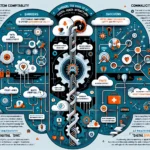The IELTS Reading section is a crucial component of the test, requiring candidates to demonstrate their ability to comprehend complex texts and answer questions accurately. One topic that has gained significant attention in recent years is “AI’s role in predicting natural disasters.” This subject has appeared in various forms in past IELTS exams and, given its relevance to current global challenges, is likely to resurface in future tests.
As we delve into this topic, we’ll explore a sample IELTS Reading passage and questions, providing you with valuable practice and insights to enhance your performance in the exam.
 AI Predicting Natural Disasters
AI Predicting Natural Disasters
Sample IELTS Reading Passage: AI’s Role in Predicting Natural Disasters
Reading Passage
The integration of Artificial Intelligence (AI) in predicting natural disasters has revolutionized the field of disaster management, offering unprecedented accuracy and timeliness in forecasting catastrophic events. This technological advancement has the potential to save countless lives and mitigate economic losses by providing early warnings and enabling better preparedness.
One of the primary applications of AI in disaster prediction is in weather forecasting. Traditional meteorological models, while useful, often struggle with the complexity and volatility of weather systems. AI algorithms, particularly machine learning models, can process vast amounts of data from satellites, weather stations, and historical records to identify patterns and make predictions with remarkable precision. For instance, IBM’s Deep Thunder project utilizes AI to provide hyperlocal weather forecasts, helping to predict flash floods and severe storms with greater accuracy than ever before.
In seismology, AI is making significant strides in earthquake prediction. While predicting the exact timing of earthquakes remains challenging, AI systems can analyze seismic data to identify potential risk areas and estimate the likelihood of seismic events. A notable example is the AI model developed by researchers at Harvard and Google, which can predict aftershocks following major earthquakes with unprecedented accuracy. This technology not only aids in immediate disaster response but also informs long-term urban planning and infrastructure development in earthquake-prone regions.
AI’s predictive capabilities extend to other natural disasters as well. In wildfire management, AI algorithms analyze satellite imagery, weather data, and topographical information to predict fire spread patterns and identify high-risk areas. This information is crucial for fire departments and emergency services to allocate resources effectively and plan evacuation strategies. Similarly, AI models are being employed to predict landslides by analyzing factors such as rainfall, soil composition, and land use patterns.
The success of AI in disaster prediction relies heavily on the quality and quantity of data available. As more data is collected and AI algorithms are refined, the accuracy of predictions is expected to improve significantly. However, it’s important to note that AI is not a standalone solution. It works best when integrated with human expertise and traditional scientific methods. Meteorologists, geologists, and other experts play a crucial role in interpreting AI-generated predictions and making informed decisions.
While the potential of AI in disaster prediction is immense, challenges remain. One significant issue is the “black box” nature of some AI algorithms, which can make it difficult for humans to understand how certain predictions are made. This lack of transparency can be problematic when making critical decisions that affect public safety. Additionally, there are concerns about the reliability of AI predictions in unprecedented scenarios or in areas with limited historical data.
Despite these challenges, the role of AI in predicting natural disasters continues to expand and evolve. Governments and organizations worldwide are increasingly investing in AI-powered early warning systems. For example, the United Nations Development Programme is implementing AI-based solutions for disaster risk reduction in various countries, demonstrating the global recognition of AI’s potential in this field.
As we move forward, the integration of AI with other emerging technologies such as the Internet of Things (IoT) and 5G networks is expected to further enhance our ability to predict and respond to natural disasters. These advancements promise a future where we can not only better forecast catastrophic events but also build more resilient communities capable of withstanding nature’s most formidable challenges.
Questions
1-5. Complete the summary below.
Choose NO MORE THAN TWO WORDS from the passage for each answer.
AI has transformed disaster prediction, offering improved (1)____ and timeliness in forecasting. In weather forecasting, AI can process data from various sources to identify patterns and make predictions. IBM’s (2)____ project provides detailed local weather forecasts. In seismology, AI helps identify (3)____ and estimate the likelihood of seismic events. For wildfire management, AI analyzes multiple data types to predict (4)____ and identify high-risk areas. The effectiveness of AI in disaster prediction depends on data (5)____ and quantity.
6-10. Do the following statements agree with the information given in the Reading Passage?
Write
TRUE if the statement agrees with the information
FALSE if the statement contradicts the information
NOT GIVEN if there is no information on this
- AI can predict the exact timing of earthquakes with complete accuracy.
- The Harvard and Google AI model can predict aftershocks following major earthquakes.
- AI is used to predict landslides by analyzing various environmental factors.
- AI algorithms in disaster prediction are always transparent and easy to interpret.
- The United Nations Development Programme is using AI-based solutions for disaster risk reduction globally.
11-13. Choose the correct letter, A, B, C, or D.
-
According to the passage, what is one of the main challenges of using AI in disaster prediction?
A. The high cost of implementation
B. The lack of available data
C. The “black box” nature of some AI algorithms
D. The inability to predict any natural disasters accurately -
How does the passage suggest AI should be used in disaster prediction?
A. As a complete replacement for human experts
B. In isolation from traditional scientific methods
C. Integrated with human expertise and traditional methods
D. Only for certain types of natural disasters -
What future development does the passage suggest for AI in disaster prediction?
A. Complete automation of all disaster response systems
B. Integration with IoT and 5G networks for enhanced capabilities
C. Replacement of all current early warning systems
D. Exclusive focus on earthquake prediction
Answer Key and Explanations
-
accuracy
Explanation: The passage states that AI offers “unprecedented accuracy and timeliness in forecasting catastrophic events.” -
Deep Thunder
Explanation: The text mentions “IBM’s Deep Thunder project” as an example of AI weather forecasting. -
potential risk areas
Explanation: The passage states that AI can “identify potential risk areas and estimate the likelihood of seismic events.” -
fire spread patterns
Explanation: The text mentions that AI algorithms “predict fire spread patterns and identify high-risk areas.” -
quality
Explanation: The passage states, “The success of AI in disaster prediction relies heavily on the quality and quantity of data available.” -
FALSE
Explanation: The passage states, “While predicting the exact timing of earthquakes remains challenging,” indicating that AI cannot predict earthquakes with complete accuracy. -
TRUE
Explanation: The text mentions “the AI model developed by researchers at Harvard and Google, which can predict aftershocks following major earthquakes with unprecedented accuracy.” -
TRUE
Explanation: The passage states, “AI models are being employed to predict landslides by analyzing factors such as rainfall, soil composition, and land use patterns.” -
FALSE
Explanation: The text mentions the “black box” nature of some AI algorithms, which “can make it difficult for humans to understand how certain predictions are made.” -
TRUE
Explanation: The passage states, “the United Nations Development Programme is implementing AI-based solutions for disaster risk reduction in various countries.” -
C
Explanation: The passage mentions the “black box” nature of some AI algorithms as a significant challenge. -
C
Explanation: The text states, “It works best when integrated with human expertise and traditional scientific methods.” -
B
Explanation: The passage mentions, “the integration of AI with other emerging technologies such as the Internet of Things (IoT) and 5G networks is expected to further enhance our ability to predict and respond to natural disasters.”
Common Mistakes to Avoid
-
Overlooking specific details: Many test-takers miss crucial information by not reading the passage carefully. Always refer back to the text when answering questions.
-
Falling for distractors: Be cautious of answer choices that seem correct but are not supported by the passage. Stick to the information provided in the text.
-
Misinterpreting negative statements: Pay close attention to negative words like “not,” “never,” or “rarely” in both the passage and questions.
-
Ignoring qualifiers: Words like “some,” “most,” or “often” can significantly change the meaning of a statement. Don’t overlook these.
-
Making assumptions: Avoid drawing conclusions beyond what’s stated in the passage, especially for NOT GIVEN answers.
Key Vocabulary
- Catastrophic (adjective): Involving or causing sudden great damage or suffering.
- Mitigation (noun): The action of reducing the severity, seriousness, or painfulness of something.
- Hyperlocal (adjective): Relating to or focused on a very small geographical community.
- Seismology (noun): The scientific study of earthquakes and related phenomena.
- Topographical (adjective): Relating to the arrangement of the physical features of an area.
- Resilient (adjective): Able to withstand or recover quickly from difficult conditions.
Grammar Focus
Pay attention to the use of conditional sentences in scientific writing. For example:
“As more data is collected and AI algorithms are refined, the accuracy of predictions is expected to improve significantly.”
This is an example of a first conditional sentence, used to discuss a real possibility in the future. The structure is:
If/When + present simple, … will + infinitive
Practice using this structure to discuss potential future developments in various fields.
Tips for IELTS Reading Success
-
Time management: Allocate your time wisely across all sections of the Reading test.
-
Skim and scan: Quickly skim the passage for main ideas, then scan for specific details when answering questions.
-
Keyword identification: Identify key terms in questions to locate relevant information in the passage quickly.
-
Practice active reading: Engage with the text by making mental notes or underlining key points.
-
Improve your vocabulary: Regularly learn new words and phrases related to common IELTS topics.
-
Read diverse materials: Expose yourself to various text types and subjects to broaden your comprehension skills.
-
Answer all questions: Even if unsure, always provide an answer as there’s no penalty for incorrect responses.
By following these strategies and consistently practicing with passages like the one on AI’s role in predicting natural disasters, you’ll be well-prepared to tackle the IELTS Reading section with confidence. Remember, success in IELTS Reading comes from a combination of strong comprehension skills, effective time management, and familiarity with the test format.
For more insights on related topics, check out our articles on AI’s role in addressing environmental degradation and how AI is being used in climate change adaptation strategies. These resources will further enhance your understanding of AI applications in environmental contexts, which could be valuable for your IELTS preparation.


